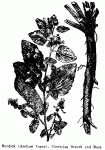DRUG NAME—Lappa.
OTHER COMMON NAMES—Cockle-button, cuckold-dock, beggar's-buttons, hurrbur, stick-buttons, hardock, bardane.
HABITAT AND RANGE—Burdock, one of our most common weeds, was introduced from the Old World. It grows along road sides, in fields, pastures and waste places, being very abundant in the Eastern and Central States and in some scattered localities in the West.
DESCRIPTION OF PLANT—Farmers are only too well acquainted with this coarse, unsightly weed. During the first year of its growth this plant, which is a biennial belonging to the aster family (Asteraceae), produces only a rosette of large, thin leaves from a long, tapering root. In the second year a round, fleshy, and branched stem is produced, the plant when full grown measuring from 3 to 7 feet in height. This stem is branched, grooved, and hairy, bearing very large leaves, the lower ones often measuring 18 inches in length. The leaves are placed alternately on the stem, on long, solid, deeply furrowed leafstalks; they are thin in texture, smooth on the upper surface, pale and woolly underneath; usually heart shaped, but sometimes roundish or oval, with even, wavy, or toothed margins.
The flowers are not produced until the second year, appearing from July until frost. Burdock flowers are purple, in small, clustered heads armed with hooked tips, and the spiny burs thus formed are a great pest, attaching themselves to clothing and to the wool and hair of animals. Burdock is a prolific seed producer, one plant bearing as many as 40,000 seeds.
DESCRIPTION OF ROOTSTOCK—Burdock has a large, fleshy taproot, which when dry becomes scaly and wrinkled lengthwise and has a blackish brown or grayish brown color on the outside, hard, breaking with a short, somewhat fleshy fracture, and showing the yellowish wood with a whitish spongy center. Sometimes there is a small, white, silky tuft at the top of the root, which is formed by the remains of the bases of the leafstalks. The odor of the root is' weak and unpleasant, the taste mucilaginous, sweetish and somewhat bitter.
While the root is met with in commerce in its entire state, it is more frequently in broken pieces or in lengthwise slices, the edges of which are turned inward. The roots of other species of Arctium are also employed.
COLLECTION, PRICES AND USES—Burdock root is official, and the United States Pharmacopoeia directs that it be collected from plants of the first year's growth, either of Arctium lappa or of other species of Arctium. As Burdock has a rather large, fleshy root, it is difficult to dry and is apt to become moldy, and for this reason it is better to slice the root lengthwise, which will facilitate the drying process. The price ranges from 5 to 10 cents a pound. The best root is said to come from Belgium, where great care is exercised in its collection and curing.
Burdock root is used as an alterative in blood and skin diseases. The seeds and fresh leaves are also used medicinally to a limited extent.
Ginseng and Other Medicinal Plants, 1936, was written by A. R. Harding.


